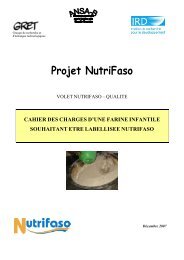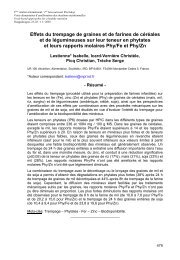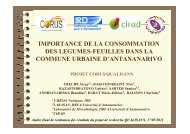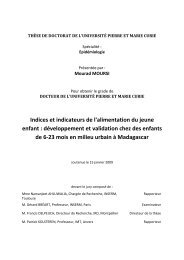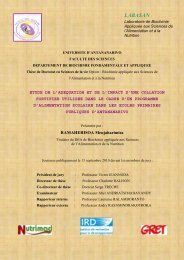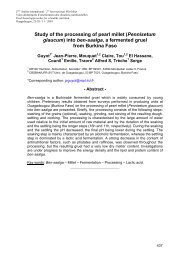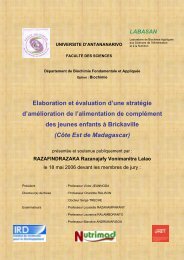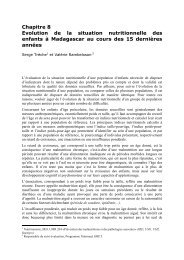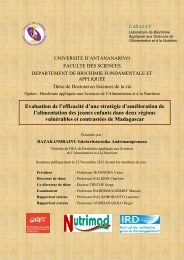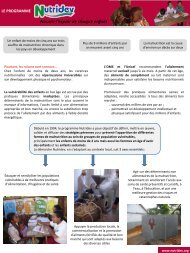THESE UNIQUE El Hassane Kéhien-Piho TOU - Nutridev
THESE UNIQUE El Hassane Kéhien-Piho TOU - Nutridev
THESE UNIQUE El Hassane Kéhien-Piho TOU - Nutridev
Create successful ePaper yourself
Turn your PDF publications into a flip-book with our unique Google optimized e-Paper software.
1564<br />
ARTICLE IN PRESS<br />
E.H. Tou et al. / LWT 40 (2007) 1561–1569<br />
Results were compared with those obtained with the<br />
traditional millet-based ben-saalga (control) previously<br />
described in Tou et al. (2006).<br />
2.4. Preparation of gruels<br />
Gruels were prepared at different DM contents by<br />
boiling the fermented paste for at least 5 min. However, to<br />
prepare gruels with high ED, a longer cooking time<br />
(10–20 min) was sometimes required to concentrate the<br />
gruel.<br />
2.5. Fermentation kinetics<br />
2.5.1. Sampling<br />
In order to describe the fermentation kinetics during the<br />
soaking and settling steps, all experiments were performed<br />
at ambient temperature and at laboratory scale using the<br />
same utensils as those used by traditional producers.<br />
Samples were taken during the soaking step (from 0 to<br />
16 h) and the settling step (from 0 to 24 h), and frozen until<br />
analyses.<br />
2.5.2. Changes in pH<br />
The pH was recorded online using a pH-meter (WTW<br />
340i, Fisher Bioblock Scientific, France). Data were then<br />
transferred onto an Excel file.<br />
2.5.3. Changes in sugar concentrations<br />
Mono- and disaccharides (glucose, fructose, maltose and<br />
melibiose) were extracted from samples and their contents<br />
were determined by High Performance Ionic Chromatography<br />
(Dionex DX 500 apparatus using a Carbo PA1<br />
column). Detection was made by pulsed amperometry.<br />
Experimental conditions are detailed in Tou et al. (2007).<br />
The results are expressed in mmol/l.<br />
2.5.4. Changes in lactic and acetic acid and ethanol<br />
concentrations<br />
Ethanol, lactic and acetic acid contents of samples taken<br />
during the soaking and fermentation steps were determined<br />
by HPLC according to the method described by Calderon,<br />
Loiseau, and Guyot (2001). The results are expressed in<br />
mmol/l.<br />
2.6. Assessment of nutritional value<br />
2.6.1. Proximate composition<br />
Protein content was determined according to the<br />
AFNOR NF V03-050 standard method (AFNOR, 1970)<br />
based on determination of nitrogen content with the<br />
Kjeldahl method with a conversion factor of 6.25. Lipid<br />
content was determined with the HT6 Soxtec system<br />
(Tecator, Ho¨gana¨s, Sweden) according to the application<br />
note Tecator No. 3144. Ash content was measured after<br />
calcination in a furnace at 530 1C. Acid Detergent Fibre<br />
(ADF) contents (cellulose and lignin) were determined<br />
using the gravimetric method of Van Soest (1963) with a<br />
Dosi-fiber (Selecta, Barcelona, Spain). Available carbohydrate<br />
contents were obtained by difference. The energy<br />
value was then calculated using the coefficients of 4 kcal/g<br />
DM for proteins and available carbohydrates, and 9 kcal/g<br />
DM for lipids, and expressed in kcal/100 g of DM of the<br />
gruel.<br />
2.6.2. Energy density<br />
The consistency of gruels was assessed using a Bostwick<br />
consistometer (CSC Scientific Company Inc., Fairfax,<br />
Virginia, USA) (Mouquet, Greffeuille, & Tre` che, 2006).<br />
Measurements were made at 45 1C and the Bostwick flow<br />
value was expressed in mm/30 s. DM content of gruels were<br />
determined by oven-drying at 105 1C to constant weight.<br />
The ED of the gruel was calculated at a Bostwick flow of<br />
120 mm/30 s, corresponding to a suitable consistency for<br />
young children (Vieu, Traore´, & Trèche, 2001), by multiplying<br />
the gruel DM content by its energy value, and<br />
expressed in kcal/100 g of gruel.<br />
2.6.3. Phytate content<br />
Phytate was extracted from 0.2 g of sample treated with<br />
10 ml of 0.5 M HCl. The phytate content was estimated by<br />
determination of myo-inositol hexaphosphate (IP6) content<br />
obtained by anion exchange HPLC separation, according<br />
to the method of Talamond, Gallon, and Trèche (1998).<br />
2.7. Enumeration of mesophilic aerobic bacteria, lactic acid<br />
bacteria, amylolytic lactic acid bacteria and yeasts<br />
Bacteria and yeasts were counted in samples of pastes<br />
taken after 0, 4, 8 and 24 h of fermentation. Aerobic<br />
mesophilic bacteria, LAB, ALAB and yeasts were counted<br />
on, respectively, plate count agar (PCA, Difco), de Man,<br />
Rogosa and Sharpe (MRS, Difco), modified MRS (without<br />
tween 80, glucose was replaced by soluble starch at 20 g/l)<br />
and Yeast Glucose Chloramphenicol (YGC, Oxoid), in the<br />
conditions described by Tou et al. (2006).<br />
2.8. Statistical analysis<br />
Each experiment was replicated three times. All analyses<br />
and counts were done in duplicate and the two resulting<br />
values were averaged. Data were submitted to analysis of<br />
variance (ANOVA), using the general model procedure of<br />
STATGRAPHIC Plus version 5.1. Statistical differences<br />
between means (Po0.05) were tested by Duncan’s multiple<br />
range test (Duncan, 1955).<br />
3. Results and discussion<br />
3.1. Fermentation kinetics<br />
3.1.1. Soaking step<br />
Changes in pH and concentrations of sugar, ethanol, lactic<br />
and acetic acids: During the soaking of the millet and of the



